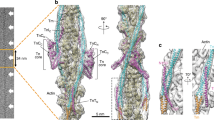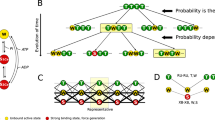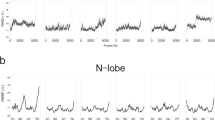Abstract
The response of the internal dynamics of calcium-saturated calmodulin to the formation of a complex with a peptide model of the calmodulin-binding domain of the smooth muscle myosin light chain kinase has been studied using NMR relaxation methods. The backbone of calmodulin is found to be unaffected by the binding of the domain, whereas the dynamics of side chains are significantly perturbed. The changes in dynamics are interpreted in terms of a heterogeneous partitioning between structure (enthalpy) and dynamics (entropy). These data provide a microscopic view of the residual entropy of a protein in two functional states and suggest extensive enthalpy/entropy exchange during the formation of a protein–protein interface.
This is a preview of subscription content, access via your institution
Access options
Subscribe to this journal
Receive 12 print issues and online access
$189.00 per year
only $15.75 per issue
Buy this article
- Purchase on Springer Link
- Instant access to full article PDF
Prices may be subject to local taxes which are calculated during checkout





Similar content being viewed by others
References
Wintrode, P.L. & Privalov, P.L. Energetics of target peptide recognition by calmodulin: a calorimetric study. J. Mol. Biol. 266, 1050–1062 ( 1997).
Murphy, K.P., Xie, D., Garcia, K.C., Amzel, L.M. & Freire, E. Structural energetics of peptide recognition: angiotensin II/antibody binding. Proteins 15, 113– 120 (1993).
Lee, K.H., Xie, D., Freire, E. & Amzel, L.M. Estimation of changes in side chain configurational entropy in binding and folding: general methods and application to helix formation. Proteins 20, 68–84 (1994).
Makhatadze, G.I. & Privalov, P.L. Energetics of protein structure. Adv. Prot. Chem. 47, 307–425 (1995).
Weber, G. Thermodynamics of the association and the pressure dependence of oligomeric proteins. J. Phys. Chem. 97, 7108– 7115 (1993).
Karplus, M. & Kushick, J.N. Method for estimating the configurational entropy of macromolecules. Macromolecules 14, 325–332 (1981).
Doig, A.J. & Sternberg, J.E. Side-chain conformational entropy in protein folding. Protein Sci. 4, 2247 –2251 (1995).
Rasmussen, B.F., Stock, A.M., Ringe, D. & Petsko, G.A. Crystalline ribonuclease A loses function below the dynamical transition at 220 K. Nature 357, 423–424 ( 1992).
Feher, V.A. & Cavanagh, J. Millisecond-timescale motions contribute to the function of the bacterial response regulator protein SpoOF. Nature 400, 289–293 ( 1999).
Stock, A. Relating dynamics to function. Nature 400, 221–222 (1999).
Akke, M., Brüschweiler, R. & Palmer III, A.G. NMR order parameters and free energy: an analytical approach and its application to cooperative Ca2+ binding by calbindin D9k. J. Am. Chem. Soc. 115, 9832–9833 (1993).
Li, Z., Raychaudhuri, S. & Wand, A.J. Insights into the local entropy of proteins provided by NMR relaxation. Protein Sci. 5, 2647– 2650 (1996).
Yang, D. & Kay, L.E. Contributions to conformational entropy arising from bond vector fluctuations measured from NMR-derived order parameters: application to protein folding. J. Mol. Biol. 263, 369–382 (1996).
Vogel, H.J. Calmodulin: a versatile calcium mediator protein. Biochem. Cell Biol. 72, 357–375 ( 1994).
Babu, Y.S. et al. Three-dimensional structure of calmodulin. Nature 315, 37–40 ( 1985).
Barbato, G., Ikura, M., Kay, L.E., Pastor, R.W. & Bax, A. Backbone dynamics of calmodulin studied by 15N relaxation using inverse detected two-dimensional NMR spectroscopy: the central helix is flexible. Biochemistry 31, 5269 –5278 (1992).
Zhang, M., Tanaka, T. & Ikura, M. Calcium-induced conformational transition revealed by the solution structure of apocalmodulin. Nature Struct. Biol. 2, 758–767 (1995).
Kuboniwa, H. et al. Solution structure of calcium-free calmodulin. Nature Struct. Biol. 2, 768–776 (1995).
Ikura, M. et al. Solution structure of a calmodulin–target peptide complex by multidimensional NMR. Science 256, 632 –638 (1992).
Meador, W.E., Means, A.R. & Quiocho, F.A. Target enzyme recognition by calmodulin: 2.4 Å structure of a calmodulin–peptide complex. Science 257, 1251–1256 (1992).
Meador, W.E., Means, A.R. & Quiocho, F.A. Modulation of calmodulin plasticity in molecular recognition on the basis of x-ray structures. Science 262, 1718–1721 (1993).
Osawa, M. et al. A novel target recognition revealed by calmodulin in complex with Ca2+-calmodulin-dependent kinase kinase. Nature Struct. Biol. 6, 819–824 (1999).
Muhandiram, D.R., Yamazaki, T., Sykes, B.D. & Kay, L.E. Measurement of 2H T1 and T1ρ relaxation times in uniformly 13C-labeled and fractionally 2H-labeled proteins in solution. J. Am. Chem. Soc. 117, 11536–11544 (1995).
Lipari, G. & Szabo, A. Model-free approach to the interpretation of nuclear magnetic resonance relaxation in macromolecules. 1. Theory and range of validity. J. Am. Chem. Soc. 104, 4546–4559 (1982).
Lee, A.L., Flynn, P.F. & Wand, A.J. Comparison of 2H and 13C NMR relaxation techniques for the study of protein methyl group dynamics in solution. J. Am. Chem. Soc. 121, 2891– 2902 (1999).
Lukas, T.J., Burgess, W.H., Prendergast, F.G., Lau, W. & Watterson, D.M. Calmodulin binding domains: characterization of a phosphorylation and calmodulin binding site from myosin light chain kinase. Biochemistry 25, 1458 –1464 (1987).
Kemp, B.E., Pearson, R.B., Guerriero, V., Bagchi, I.C. & Means, A.R. The calmodulin binding domain of chicken smooth muscle myosin light chain kinase contains a pseudosubstrate sequence. J. Biol. Chem. 262, 2542– 2548 (1987).
Seeholzer, S.H. & Wand, A.J. Structural characterization of the interactions between calmodulin and skeletal muscle myosin light chain kinase: effect of peptide (576–594)G binding on the Ca2+-binding domains. Biochemistry 28, 4011– 4019 (1989).
Roth, S.M. et al. Structure of the smooth muscle myosin light-chain kinase calmodulin-binding domain peptide bound to calmodulin. Biochemistry 30, 10078–10084 ( 1991).
Roth, S.M. et al. Characterization of the secondary structure of calmodulin in complex with a calmodulin-binding domain peptide. Biochemistry 31, 1443–1451 ( 1992).
Mittermaier, A., Kay, L.E. & Forman-Kay, J.D. Analysis of deuterium relaxation-derived methyl axis order parameters and correlation with local structure. J. Biol. NMR 13, 181–185 ( 1999).
O'Neil, K.T. & DeGrado, W.F. How calmodulin binds its targets: sequence independent recognition of amphiphilic α-helices. Trends Biochem. Sci. 15, 59–64 (1990).
Gellman, S.H. On the role of methionine residues in the sequence -independent recognition of nonpolar protein surfaces. Biochemistry 30, 6633–6636 (1991).
Siivari, K., Zhang, M., Palmer, A.G. & Vogel, H.J. NMR studies of the methionine methyl groups in calmodulin. FEBS Lett. 366, 104–108 (1995).
Chin, D. & Means, A.R. Methionine to glutamine substitutions in the C-terminal domain of calmodulin impair the activation of three protein kinases. J. Biol. Chem. 271, 30465– 30471 (1996).
Edwards, R.A., Walsh, M.P., Sutherland, C. & Vogel, H.J. Activation of calcineurin and smooth muscle myosin light chain kinase by Met-to-Leu mutants of calmodulin. Biochem. J. 331, 149–152 (1998).
Kay, L.E., Muhandiram, D.R., Farrow, N.A., Aubin, Y. & Forman-Kay, J.D. Correlation between dynamics and high affinity binding in an SH2 domain interaction. Biochemistry 35, 361–368 ( 1996).
Constantine, K.L. et al. Backbone and side chain dynamics of uncomplexed human adipocyte and muscle fatty acid-binding proteins. Biochemistry 37, 7965–7980 ( 1998).
Gerstein, M., Tsai, J. & Levitt, M. The volume of atoms on the protein surface: calculated from simulation, using Voronoi polyhedra. J. Mol. Biol. 249, 955–966 (1995).
Jacrot, B., Cusack, S., Dianoux, A.J. & Engelman, D.M. Inelastic neutron scattering analysis of hexokinase dynamics and its modifacation on binding of glucose. Nature 300, 84– 86 (1982).
Bracken, C., Carr, P.A., Cavanagh, J. & Palmer, A.G. Temperature dependence of intramolecular dynamics of the basic leucine zipper of GCN4: implications for the entropy of association with DNA. J. Mol. Biol. 285, 2133–2146 (1999).
Clackson, T. & Wells, J.A. A hot spot of binding energy in a hormone–receptor interface. Science 267, 383–386 (1995).
Urbauer, J.L., Short, J.H., Dow, L.K. & Wand, A.J. Structural analysis of a novel interaction by calmodulin: high-affinity binding of a peptide in the absence of calcium. Biochemistry 34, 8099–8109 (1995).
Bax, A., Delaglio, F., Grzesiek, S. & Vuister, G.W. Resonance assignment of methionine methyl groups and χ3 angular information from long-range proton-carbon and carbon-carbon J correlation in a calmodulin–peptide complex. J. Biol. NMR 4, 787–797 (1994).
Brüschweiler, R., Liao, X. & Wright, P.E. Long-range motional restrictions in a multidomain zinc-finger protein from anisotropic tumbling. Science 268, 886–889 (1995).
Tjandra, N., Feller, S.E., Pastor, R.W. & Bax, A. Rotational diffusion anisotropy of human ubiquitin from 15N NMR relaxation. J. Am. Chem. Soc. 117, 12562–12566 (1995).
Lee, L.K., Rance, M., Chazin, W.J. & Palmer, A.G. Rotational anisotropy of proteins from simultaneous analysis of 15N and 13CΣϒβα/Σϒβ nuclear spin relaxation. J. Biol. NMR 9, 287–298 (1997).
Lee, A.L. & Wand, A.J. Assessing potential bias in the determination of rotational correlation times of proteins by NMR relaxation. J. Biol. NMR 13, 101–112 (1999).
Brüschweiler, R. & Wright, P.E. NMR order parameters of biomolecules: a new analytical representation and application to the Gaussian axial fluctuation model. J. Am. Chem. Soc. 116, 8426–8427 (1994).
Koradi, R., Billeter, M. & Wüthrich, K. A program for display and analysis of macromolecular structures. J. Mol. Graphics 14, 51– 55 (1996).
Acknowledgements
We thank K. Sharp and J. Kranz for helpful discussions. This work was supported by a grant and a postdoctoral fellowship from the National Institutes of Health.
Author information
Authors and Affiliations
Corresponding author
Rights and permissions
About this article
Cite this article
Lee, A., Kinnear, S. & Wand, A. Redistribution and loss of side chain entropy upon formation of a calmodulin–peptide complex. Nat Struct Mol Biol 7, 72–77 (2000). https://doi.org/10.1038/71280
Received:
Accepted:
Issue Date:
DOI: https://doi.org/10.1038/71280
This article is cited by
-
Simultaneous measurement of 1HC/N-R2′s for rapid acquisition of backbone and sidechain paramagnetic relaxation enhancements (PREs) in proteins
Journal of Biomolecular NMR (2021)
-
The role of NMR in leveraging dynamics and entropy in drug design
Journal of Biomolecular NMR (2020)
-
Characterization of the dynamics and the conformational entropy in the binding between TAZ1 and CTAD-HIF-1α
Scientific Reports (2019)
-
The exchanged EF-hands in calmodulin and troponin C chimeras impair the Ca2+-induced hydrophobicity and alter the interaction with Orai1: a spectroscopic, thermodynamic and kinetic study
BMC Biochemistry (2015)
-
Contrasting roles of dynamics in protein allostery: NMR and structural studies of CheY and the third PDZ domain from PSD-95
Biophysical Reviews (2015)



